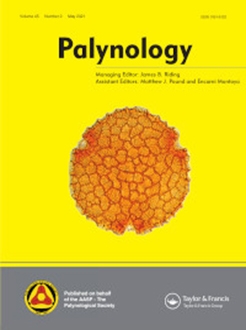Palynological analysis of Site M0077A in the Chicxulub impact crater has yielded a record of the immediate Cretaceous/Paleogene (K/Pg) recovery from ground zero of the end-Cretaceous mass extinction, followed by a record of the Paleocene–Eocene Thermal Maximum (PETM) and later Ypresian (Eocene), including the Early Eocene Climatic Optimum (EECO). Eight specimens of the dinoflagellate cyst Trithyrodinium evittii have been observed near the base of the K/Pg transitional unit; these likely represent a post-impact dinoflagellate disaster recovery assemblage deposited within several days following the impact, although the possibility that some or all of the T. evittii specimens are reworked Maastrichtian cysts cannot be fully excluded. Despite high-resolution sampling of the lowermost Paleocene successions, the oldest identifiable terrestrial palynomorphs observed in the Site M0077A core, two specimens of Deltoidospora fern spores, occur at least ∼200,000 years after the impact. Other than these occurrences, the Paleocene section is nearly barren in terms of palynomorphs, likely a result of poor preservation of organic material combined with a long recovery time for vegetation in the vicinity of the crater. Pollen and fungal spore concentrations spike in an anoxic dark shale deposited during the PETM around 56 Ma, with a diverse pollen assemblage indicating the presence of a coastal shrubby tropical forest in the geographic vicinity, likely in the Yucatán Peninsula to the south. In the marine realm, this interval is characterized by thermophilic assemblages of dinoflagellate cysts. Stratigraphically constrained cluster analysis identified four statistically robust sample clusters in the lower Eocene successions, with Malvacipollis spp. and Milfordia spp. abundances driving the highest average dissimilarity between clusters. A second notable spike in palynological concentrations above the PETM section may represent another early Eocene hyperthermal event. Pollen and plant spore concentrations generally increased during the EECO, associated with increases in terrestrial input during basin infilling.
How to translate text using browser tools
3 May 2021
Palynology from Ground Zero of the Chicxulub Impact, Southern Gulf of Mexico
Vann Smith,
Sophie Warny,
Johan Vellekoop,
Vivi Vajda,
Gilles Escarguel,
David M. Jarzen
ACCESS THE FULL ARTICLE
It is not available for individual sale.
This article is only available to subscribers.
It is not available for individual sale.
It is not available for individual sale.

Palynology
Vol. 45 • No. 2
May 2021
Vol. 45 • No. 2
May 2021
Cretaceous–Paleogene boundary
Dinoflagellate cysts
Eocene
Mexico
Paleocene
PETM
pollen





